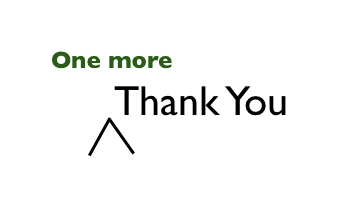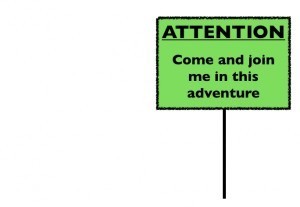Rajesh Setty's Blog, page 7
May 5, 2013
One More Thank You
Can one more Thank You make a big difference?
The answer is Yes – just ask any person who received that Thank You from you.
Why is it “one more” Thank You?
The focus of this article is on that “one more.” The concept is so simple but one that has changed my life in a very profound way. Let’s get to the heart of it right away.
[ Note: Printing this page might make this easy to do this exercise but it not required ]
Think about your most recent “win” – be it in your personal or professional field. A win could be anything that has moved the needle in a significant fashion in your life – something that has made a real difference to you and/or your loved ones.
Now, list all the people who have played a part in that win. Remember to list even the ones that have played a minor part too (this is VERY important)
What was the win? ( one or two lines about your win)
——————————————————————————————————
——————————————————————————————————-
Apart from you who helped you get this win? (write the name and what contribution they made)
1. ___________________________________________________
2. ___________________________________________________
3. ___________________________________________________
4. ___________________________________________________
5. ___________________________________________________
6. ___________________________________________________
7. ___________________________________________________
8. ___________________________________________________
9. ___________________________________________________
10. ___________________________________________________
Add more lines as necessary.
Take as much time as required but the goal is to list EVERYONE that helped you in any small way to get you this win.
When you think you are done with the list, take another 2 minutes to think of anyone else that you should add. You have to get EVERYONE that played a part – however big or small that part was.
Now, comes the part
Go through the list and check off all the people that you have explicitly thanked (even a simple thank you email is fine) so far. If you have checked off EVERYONE in the list, hat’s off to you. In most cases, I have seen that more than 50% of the people in the list are not checked off – meaning people have not taken the time to thank those that got them a win that mattered to them.
Your mission if you choose to accept it is to send one more thank you note for someone that’s not checked off in the list. You need to do it TODAY. Then, if you want bonus points, keep sending one more thank you note before the end of the week until you check off EVERYONE in the list.
I won’t say why this will work but please try and find it out for yourself. Whoever has done this exercise have actually come back and thanked me for this. if you care to share, please add your comment explaining your own experience.
All the best!
To read next: The Price of Not Thanking Enough.
For those that are more interested:
Why does this work?
In general, people over-estimate what they brought to the table for a win AND underestimate what others and luck brought to the table.
An exercise like the above for every significant win will bring out a lot that you might have taken for granted. Do this exercise regularly and soon you will stop taking anything for granted. Plus, you will start appreciating all the blessings around you.
Update: My friend Dilip Saraf‘s addition as a comment at LinkedIn is worth noting:
Great post, Rajesh, as always! What I find is that merely a Thank you is often not enough. What most people miss in their message is being specific, personal, and timely. For example, to you I’d write: “Thanks, Raj, for this reminder! I went through your list and just realized a number of people I had ignored in expressing my gratitude to them when what they did selflessly made a BIG difference in MY life! Now I feel complete. You are a good friend to have!”
Thanks, Dilip for the insightful addition.







April 29, 2013
Mini Saga #128 – Readiness
Mini Saga #128 – Readiness
It was Dave’s first camping trip with his three friends. Tired after hiking all day, they wanted to sleep early in their tent. Seeing three pairs of earplugs in Dave’s hand, Sam asked him, “Why do you want three pairs of ear plugs?” Dave smiled, “They are not for me.”
Readiness involves caring for yourself AND caring for others involved.
Note:
1. A mini saga is a story told in exactly 50 words. Not 49 or 51 but exactly 50.
2. You can download a photographic manifesto of Mini Sagas at ChangeThis. Here is the link – Mini Sagas: Bite-sized Wisdom for Life and Business (PDF, 2.9MB).
3. For a complete list of Mini Sagas, please see the entire list here or at Squidoo







April 18, 2013
Why some smart people become oblivious to their stupid actions
Have you seen some people do stupid things?
More importantly, have you seen some smart people do stupid things AND are completely oblivious to that fact?
If you are curious to know why this happens, please read the outcome of my mini-research project on this topic.
[ Note: Replace "You" with any smart person in question ]
Over the last few weeks, I asked a bunch of people about stupid things that they have done and what was the cause of that. I got dozens of interesting answers. Here is the partial list:
Didn’t seem stupid when I did it.
Error in judgment, should not have happened
I do stupid things all the time. The smart things I do more than compensate for these stupid things
Well, time will tell if it was really stupid. The world will see
I am a risk taker unlike others
Mistakes happen to everyone. I am a human after all
I am not alone in this, Am I?
I move fast in comparison to most others and when you are that way, you slip and fall sometimes
I don’t know what happened
It is silly, I know. I just move on…
Ah… those were the days
Well, you live and learn
You are I are not evergreen heroes who will never do stupid things. If you recently did something stupid, it will not be the first time you did something like that nor it will be the last time. Unless, you did something so stupid that you reached a point of no return, this is not a real problem. You normally recover quickly and stay safe until your next act of stupidity.
The problem is when you are oblivious to your stupidity – if you don’t realize that you are doing something stupid, it is not easy to recover because you won’t make an attempt to do anything else. The telltale sign of that situation is that you shun accountability AND move the blame to someone (e.g. Your Boss, your spouse) or something (e.g. Changes in law, luck) very quickly.
Why does this happen?
Here is what happens in many cases. It starts long before this stupid act.
1. It starts with defying normal boundaries in the wrong direction
You test the boundaries by breaching them a little beyond normal limits. A trivial example: if everyone comes to office at 9am and it’s OK to be late by up to an hour, you will come to the office at 10.30am. You get away with it because you are smart and you make up for that lack of discipline with your super duper skills.
2. You give repeated deviations a positive twist
You continue to break the normal boundaries and rather than catching yourself as a repeat offender, you give them a positive twist with justifications that others can’t easily refute (e.g: out of the box thinking, creative people always are different etc.)
3. You start believing your own story
Giving a positive twist was a way of getting away with your “deviant” actions. The real problems start when you start truly believing that you are not at fault. Others around you are polite to say anything else and if nobody is making a ruckus about your “deviant” actions, then they are not that “abnormal” – so they are OK.
4. You increase the deviations and repeat steps 1 to 3
The problem with repeated deviations is that they become “normal” routine in your mind. The world notices the deviations but won’t speak much and in your early stages of fast-growth career, these things won’t matter much.
5. You forget to notice that your accomplishments are not commensurate with your smartness
This is an important point because if your accomplishments are commensurate with your smartness (in a manner that others can vouch for) then you can continue to get away with your “deviant” actions because valuable accomplishments in most cases will trump noticeable aberrations. For a deeper discussion about this topic, please read: The Inflection Point around 40.
6. You create a mess with your macro deviation:
Then, it happens – the stupid act. It had to happen one day or the other but that happens to be today. Because of the way you kept deviating incrementally from your “normal boundaries” you didn’t realize that your deviations are quite BIG in comparison to the “normal boundaries” as defined by the world. Over a period of time, collective and progressive micro deviations have resulted in a macro deviation that is easily noticeable.
You are oblivious to this because you don’t think about deviations that much. Your actions are well within your “normal boundaries” as you kept stretching those boundaries over a long period of time with minor breaches. This time someone out there will also point this out to you as it is clear by now that your accomplishments don’t match with your smartness for them to keep giving you a long leash. The party had to end one day.
What can you do?
This is a case where prevention is better than cure.
Have someone else on your side (mentor, confidant) ALWAYS. That someone MUST be competent AND candid with you. That someone must be one who can call you out on your micro-deviations along the way. It is also important that you trust that someone without judging them or justifying your actions. If you are in the fantasy land for too long, you will pay a price sooner than later.







April 8, 2013
9 Points to Ponder
I carry a short stack of notecards in my bag just to make notes for myself. Many of these are things that I would have said in a conversation or reflected upon post a conversation.
As I was browsing through my stack from the last few weeks, I found nine points to ponder. Here they are (in no particular order)
1. Attach yourself to the effort; detach yourself from the outcome
Outcomes are always uncertain because EVERYTHING has to go right to reach a certain outcome (Note for any digital electronics geeks: Think AND gates) so really anything can happen. A key component that has to go right is YOUR effort. If there is ONE thing that you have maximum control of – it is your effort. So, attach yourself to the effort and detach yourself from the outcome.
2. Empathize with the actions of others as much as possible; Always OWN your reactions to the actions of others.
A surefire recipe for disaster is to base your happiness on other people’s actions. People act the way they do for a variety of reasons and it is IMPOSSIBLE for you to understand their logic completely. You can empathize with them as much as possible but for sure should OWN your reactions because your life is made up of a series of such reactions.
Note: This does not mean that you should be super-stoic and take whatever is thrown at you. Your reaction to utter nonsense can be to disengage gracefully.
3. Learn from your successes and your failures. Most importantly, learn from the failures and successes of others.
Life is too short for you to learn from your own successes and failures. You may pay dearly if you choose that path. In some cases, sheer stupidity may take you to a point of no return. However, there is no dearth of lessons you can learn from the successes and failures of others if you are OPEN to it. It is a far cheaper option compared to the former.
4. Be educated. Be entertained. But NEVER confuse one for the other
There is a time for entertainment and there is a time for education. The problem comes when you confuse one for the other. Imagine you are watching a few TED videos because it is cool to say that you watched a few cool TED videos. It is pure entertainment until you create something meaningful out of the action of watching these videos. You will be fooling yourself (and feeling good about it) if you confuse entertainment for education.
5. Be an opportunist. Capitalize on EVERY single opportunity to GIVE.
Being an opportunist is wrong unless you are constantly looking for “opportunities to GIVE.” There may be a moral reason (it’s the right thing to do) reason for giving but honestly, there is a practical reason to do so too. Giving is what invokes probably the most powerful force on earth – the power of reciprocation.
If anything invest in yourself to increase your capacity to drop the costs of giving meaningful gifts – this alone will supercharge your power and influence.
6. If you think it’s hard to fill in someone’s shoes, try just being yourself
Granted, it’s hard to fill in someone’s shoes especially if they are big 
What’s harder is just to be yourself – to capitalize on your unique strengths to make a meaningful impact.
Why?
There are no ready templates to be YOU. You need to be creative, invent what works for you and keep innovating to create impact with your unique strengths. You need to do this while fighting the temptation to just follow.
7. Making money is good. Making meaning is better. Making meaning while making meaning is the best!
On one end there is money for the sake of money. On the other end, there is meaning. Whatever be your view about money, I think you will agree that with money it gets easier to create an impact that’s far reaching. So, rather than shying away from making money, go towards making both – meaning + money.
Note: There are always exceptions of people with no money making a massive impact. For every one such person, there will be ten who can make that kind of impact with money
8. You can never change what happened but you can ALWAYS change how you look at what happened.
It is clear to us all that past cannot be changed but nobody can stop you and me from reframing our past to make us more powerful. Just like in #2, you have the power to choose your reaction or the frame with which you see your past. You can make it such that it’s dis-empowering or you can make it empowering – your choice!
9. Not having an opportunity to sing is a small problem compared to not having a song to sing.
It’s actually easy to complain that your circumstances have not provided you an opportunity to sing.
Think about it
Who gets to sing?
In general, the “one or two of the best of the available options.”
Your task is really cut out – your goal is to be one of the “best available among available options.” This means only one thing – relentless investment in yourself AND having that sing to sing that others want to listen.
Have a great week ahead!







April 5, 2013
Why many smart people can’t get buy-in from others
I have been thinking about this question for a while and written bits and pieces on the topic before.
Like many other mini-research projects, I embarked on a journey to find out the answer. Here is what I found – some reasons may be obvious but may be not all of them. You be the judge
Here are the reasons (in no particular order)
[ Note: "You" is used in the article for simplicity and not to imply that you face these issues ]
1. You may NOT be communicating well enough: People buy-in to the story they are told. If the story is not communicated well, there is nothing to buy-in. Granted, the vision is clear in your head but you have not taken the time to craft a story to make it clear to the audience. Without a good story, all bets are off.
2. Buy-in requires future mindshare commitment: Buying-in to a concept is not a spot activity but a promise for future investment of time, energy and mindshare. Some smart people don’t realize that they are not just asking for “Yes” now but a “Yes” now AND a future commitment for a long period of time. Not everyone is ready to make that commitment. Solution? Make the ask smaller and more digestible and one can always expand the scope later.
3. They didn’t address the “belief filter” right: One step before the buy-in happens, the audience needs to believe the story. Every person passes new ideas through their own “belief filters”. One person’s belief filter may include a simple smell-test of future potential and they should be fine to move to the next stage. On the other extreme, their “belief filter” may include an elaborate investigation of proof points on your claims. There is a spectrum out there on how people view the world. What needs to be presented on one end of the spectrum is different from what needs to be presented on the other end of the spectrum. Many people tell the SAME story to everyone and are baffled that only a few people “get it.”
4. Your story involves no participation from the listener: Your story is good for you but how is it good for the listener. If you want your listener to buy-in, then you better tell a story that involves them or else it’s a lost cause. It is too much work for the listener to figure that part out on their own.
5. Your proposition is flawed and they are too polite to point it out: You present an idea and they nod their head in agreement. At least that’s what you think but in their mind the proposition is flawed AND they just don’t want to bother or have the energy to argue and fix it. It is low-cost for them to just indicate agreement but move on to other things rather than debate about it. If you mistake their politeness to be a form of support, you are mistaken. Confronting reality may give you short-term pain but it’s better than long-term misery.
6. They don’t see a positive possibility for their future as a result of buying-in: As we covered before, buying-in to an idea is a serious investment of resources now and in the future. It makes sense to invest those resources if they see a positive possibility for their future post buying-in. They need to see this in comparison to the already available alternate opportunities as the opportunity you presented will COMPETE with alternate available options. It is your job to establish the value and communicate it.
7. They have to buy-in to YOU first! This is probably the biggest and most overlooked reason. People work with people and your listeners are no different. If you have not given enough reasons to buy-in to YOU first, there is no point in presenting an opportunity as that won’t even be considered
In summary, your smartness helps but does not give you a passport to get buy-in to your ideas. You need to both – work on yourself PLUS work on your ideas to make them compelling.
What next?
Please read: How to Sell Your Ideas







April 3, 2013
How to CRAFT a conversation that moves the needle
Think about all the conversations you had today.
Question: How many of these conversations moved the needle meaningfully?
Now, think about all the conversations you had in the last 7 days
Question: How many of these conversations moved the needle meaningfully?
Lastly, think about all the conversations you had in the last 30 days
Question: How many of these conversations moved the needle meaningfully?
If you are happy with your answers to the above question, you can conveniently skip the rest of the blog post as time is of essence. If you think there is a room for improvement, I am confident that you will enjoy the rest of the article.
Here are some ideas
1. You have to focus on the ROII: If you want to have a conversation that moves the needle meaningfully, it starts with your intention. You should have WANTED to make an impact. Granted, you are investing your time in this conversation but you should be aware that the other person is investing his or her time too and THEY deserve to get a good return for that investment – in other words you need to provide a return on investment for that interaction (ROII)
2. You MUST care as if it’s your own: In other words, empathy has to be sincere. You have to get into their shoes and feel what they are feeling. Once you care as if its your own, you will not dismiss anything prematurely. Honestly, you will not be the judge of whether you care as if it’s your own – they will.
3. Drop your agenda: If there is one thing that will muddy the waters, it will be bringing your own sweet agenda to the mix. It is not to say that you sacrifice your concerns but to keep them to as minimum as possible as the focus is THEM and not YOU.
4. Understand their strengths: Now, before you conclude that we are entering the “cliche zone” remember that all you need to identify their strengths is to observe keenly where they will steer their conversation. That will provide clues to their strengths.
5. Understand their weaknesses and constraints: Just like topics related to their strengths are where they will gravitate towards, topics related to their weaknesses are what they will want to avoid. Not only their weaknesses are against them but also the constraints (e.g.: currency, connections etc.) – it is your job to quickly identify both the weaknesses and constraints.
6. Create magic: What is magic? It is a collection of possibilities to be capitalized through their strengths within the set constraints. I didn’t say this was going to be easy but if you don’t aim to create magic, you just won’t. Once your mind starts working with this framework, sooner than later, you will become very good at it. You have mastered this when you can create magic even in a super short conversation.
7. Get their buy-in for action: The last step is to get their buy-in for what specific action they should take next. The actions might have been outlined by you or them – it doesn’t matter. But they need to buy-in enough to take that action. Why? Because real progress happens only when an action is taken – not when there is a promise to take action.
Now, my humble request to you is to go and CRAFT that conversation that move the needle to someone that matters to you.
Photo Courtesy: dingatx on flickr.







March 31, 2013
How to Capitalize on Your Most Underestimated Asset
Let’s start with a related question
What is an asset (when put to work) that will change the trajectory of your life positively?
If it seems like there are many possible answers to the above question, you are right. I agree. Let us add a qualifier to the question.
What is an underestimated asset (when put to work) that will change the trajectory of your life positively?
Here’s the answer
It is your “next autonomous block of time”
Note: “block” here refers to reasonable amount of time and could be as little as 60 minutes.
So, let us look at this in bit more detail:
Next autonomous block of time.
There are three parts to this
1. Next: We are not talking about “sometime” but the upcoming block of time.
2. Autonomous: Here we are referring to that block of time where you have relatively more choice and freedom on how you will invest that block of time. Most people have very little autonomy and many don’t know that they don’t have autonomy. In this block of time, you can pretty much choose to do what you want.
3. Block of time: Here we are talking about a reasonable chunk of time where you can meaningfully think and act on things that matter. Depending on your current level of power and influence this block of time could be as little as 10 minutes but for now assume that it’s at least 60 minutes.
This is the most underestimated asset with you right now. Whether you were aware of this or not does not matter much. Now that you ARE aware, let us look at what you can do to capitalize on this.
1. It starts with awareness of the power: If you are not aware of the enormous power of the next autonomous block of time, that block of time will be like any other block of time – it will be gone before you know it. Unless you are ultra-powerful, your next autonomous block of time will come at a premium. Only you have the power to make it meaningful or squander it.
2. Decide how you will be accountable: Ultimately you will be the person who will determine what the outcome of your thinking and action during the “next autonomous block of time.” Decide well in advance how you will hold yourself accountable.
3. Use ThinkLists to amplify the ROI: To Think Lists are like To Do Lists except that you note down things to think about rather than tasks to complete. You can read more about to think lists here.
4. Get good help: The beauty of having an autonomous block of time is that you choose to think and act however you want to. But “what” will that be? How do you know “whatever” you choose is the right thing to think and act? How do you know that you have the capacity to make the right choices? This is where getting “good help” in the form of a mentor will be golden. Read 10 good reasons to get a mentor.
5. Refine regularly: How you spent this block of autonomous time will not be how you will spend that similar block of time next year. Why? If you got this right, you will grow in both power and influence. The game slowly changes and you will notice it. This means the same rules don’t apply hence you need to refine your approach on a regular basis.
Remember that there are things working against you to make the most out of the next autonomous block of time. There are businesses out there that want the share of your mindshare for their benefit rather than yours. There are people out there that are crafting messages that make it look like engaging with what they want you to do in this time is the right thing for YOU. Then there are movies, entertainment and ________ (the list goes on) that makes you think that you MUST engage with them. You have to win this fight and you have the power to do it.
Have a great week ahead!







March 30, 2013
A welcome hurdle
How do you know if someone is truly committed to take action?
[ By action I mean doing something that will put something at stake ]
Short answer: Wait and watch. If there is no change in status quo in a reasonable time, then something was a on a “wishlist without a deadline to take action.”
That seems obvious but..
What if you want someone to take action?
or better yet..
What if you want to detect who will take action?
If you know who will take action, you can invest more on those people rather than go on a crusade to change the world. You have limited time and it is better spent where there is a possibility of a reasonable ROI.
Here is what you can do to detect who will take action:
Present them with a welcome hurdle. A welcome hurdle is something that they have to do that takes real time, energy and mindshare. This gating activity should cause “enough” pain and discomfort that in order to complete the activity they have to “experience being out of their comfort zone.”
If they are willing and actually take that step and navigate that hurdle, the chances are higher that they will up for the task at hand. They may not succeed but at least they have proven to you that they are willing to take the next step.
I have used the concept of “welcome hurdle” with people who come with all kinds of requests. Examples include:
* “I think I have an idea and I want to start a company”
* “I am ready to write my book”
* “I can’t wait to lead that charity project”
* “I want you to be my mentor”
If every “best intention” could get a dollar reward, there would be lot more millionaires in the world. However, nothing happens until you take action. And if you can’t take a small action, then chances are that you won’t take a big action.
What would be an example of a welcome hurdle?
If someone says I am ready to write a book and want to meet with me to discuss it, I might simply send them a detailed template to write a book proposal and send it back to me so that I can review and be ready for a conversation.
What happens next?
Most of the times, the case is closed and I never hear back from them.
Here is another one:
I announced The Art of Leverage course where I teach a handful of people the basics of increasing their leverage recently. Everyday, I get several people who express interest. Without a delay, I use WittyParrot (see video) to send them a welcome hurdle. After that I forget about them because I know from experience that very few people really will take action. If they cross the hurdle, I will take more action, else my investment is limited to the few seconds I took to set the welcome hurdle.
In summary, a welcome hurdle is a carefully crafted filter that will save you time, energy and mindshare.
Photo Courtesy: Tulitomaatti on Flickr







March 24, 2013
Observe a little, learn a lot
The fast-paced world you and I lived in has one unintended side effect – robbing you of your ability to stop and observe a little. Why? You are bombarded with a stream of information from so many different directions. You get a feeling that the “next thing” might be more interesting than the other. Since there is always that “next thing” right around the corner (may be in the next email, text or tweet available on your smartphone) you tend to skim through the current one.
Here are a few examples where you can observe a little and can learn a lot more
1. Waterproof iPhone cover
This is on the cover of SkyMall – something they thought as the best available item to be featured on the cover. How useful is this item really? Think about your own case? How many times have you dropped your phone in water or wanted to go for a swim keeping your iPhone close to your heart?
If what’s featured on the cover is any indication, you can only guess the utility value of the remaining items within the catalog. It’s a good catalog for entertainment, though.
2. TSA Image Upgrade
You can see this notice in the wait line of many airports. The notice says that one out of four TSA agents are veterans.
What does this mean? Many things. On one end, this is an attempt by TSA to upgrade their image and on the other end it shows that options for veterans are very limited if one out of four TSA members have to join the TSA.
3. Even More by JetBlue
This is a pitch by JetBlue to upgrade to a select set of seats for a few more dollars. The reasons to upgrade:
a) more leg space
b) early boarding
c) priority access to overhead bins
Think about it – if you board early, you WILL have priority access to overhead bins. So the third item is superfluous. Why did JetBlue choose to include that? Simply because there is not enough value to upgrade and they HAVE to find some fluff to add.
4. Dashboard fuel indicator
Senthil Nayagam from Rails Factory showed this to me first.
It was always there and I never observed it. It is a fuel indicator that shows on which side of the car is your fuel tank located (at least in most cars). It’s a small arrow right next to the image of the fuel tank. It was there always but never looked it before.
What have you observed recently?







March 19, 2013
William Miller on Business Model Innovation
I have known Dr. William Miller (co-founder of Value Centered Innovation) for a number of years and every conversation with him on business model innovation and beyond has been delightful and insightful. Hers is a quick interview with him on the topic.
[ Note: If you are in the bay area on March 28, you have an opportunity to meet Dr.William Miller as he is the featured speaker at the SIPA event. You can register here and if you use coupon code SIPA25, you will get $5 off ]
Now, to the interview
RS: Is the main purpose of a business model to define how the company will make money?
WM: No business is an island, separate and independent from the society it operates in. Its actions impact not only itself, but a wide range of constituents with whom the business is inter-dependently bound.
In this holistic perspective, the main purpose of a business model is to define the over-arching purpose of a business in terms of the contribution and impact it can make to the larger whole of society, and how it is structured to achieve that purpose.
The normal way of thinking about a business model is “what is the value proposition” it offers. A value proposition is the promise of value to be given to a constituent (customer, client, community, etc.). The source of measuring the “value” is the set of “values” held by the organization and its constituents.
“Values” represent what is most important to us. In an expanded way of thinking of a business model, the value proposition is held within a larger context of personal, organizational, and societal values. As those values might change over time, a value proposition might gain or lose relevance.
For example, as the societal values of environmental sustainability have arisen over the past decade(s), the value proposition of businesses have had to shift to offer “green” products to match those values.
This brings to light the concept of a “business model with a conscience” guided by the highest human values and aspirations for serving that larger whole of stakeholders with whom the business is inter-dependently linked.
RS: What are the main components of a business model?
WM: A business model describes how we create, deliver, and produce value – where “value” includes not just financial flow, but also personal, social, cultural, and other benefits. A business model includes eight factors:
Principles: The purpose and values that shape the model
People: The relationships with all stakeholders
Product: The products and services offered to customers
Process: The systems and practices by which work gets done
Partners: The allied people and organizations who enable the model
Planet: The means of sustaining the earth’s resources
Prosperity: The flow of benefits and well-being
Proposition: The promise made to constituents
Any one or two of these factors can be the driving force(s) for the business model. For example:
• Charles Schwab disrupted the brokerage industry in the 1970-80s using a business model driven by Principles of high ethics, no conflicts of interest, being trustworthy, and helping everyone become financially fit
• Fuji Xerox took a lead in the electronics industry using a business model driven by Planet considerations, developing a line of copiers that minimized the use of new raw materials while also minimizing emissions from manufacturing them
• Dell Computers changed the way the personal computer industry operated using a business model driven by Process innovations in manufacturing and inventory, offering customized computers assembled according to a customer’s own specifications
• The Grameen Bank (Bangladesh) revolutionized banking services using a business model driven by People considerations: how to extend banking to, and create employment opportunities for, poor men and women
RS: What are the larger considerations to defining and innovating a business model?
WM: There are many assumptions about the purpose/goals of business in general, and about the nature of life in society, that always form the foundation for a business model. Over the past 125 years, four co-existing contexts have emerged: rationalist (from the early 1900s), humanistic (from the 1950-60s), holistic (from the 1970-80s), and spiritual-based (from the 1990s). The first consideration for business model innovation is to be conscious, clear, and explicit about which context and set of assumptions will drive the business model.
The second, larger consideration is to define the larger scope of outcomes you strive for. Eastern cultures call for a multi-level definition of personal and social prosperity that occurs within the bounds of harmony within creation, and for fulfillment of desires within the bounds of fulfilling our higher human nature.
Keeping our ambitions and intentions for prosperity and fulfillment of desires within the bounds of harmony with creation and fulfilling our higher nature – these are essential for a healthy business and society.
RS: Is business model innovation a subject only for top level executives?
WM: A person might play a role in their company’s business model in various ways, such as researching a new product, marketing a service, developing the company’s talent base, providing customer service, streamlining a work process, ensuring quality, conserving natural resources, serving a strategic partnership or even designing the business model itself.
When we understand our own company’s business model – and the recurring need and means to innovate that model – we work more collaboratively and help enable personal, organizational and stakeholder success. We can then participate in anticipating when a new business model is needed to lead or respond to changing market and societal conditions.







Rajesh Setty's Blog
- Rajesh Setty's profile
- 6 followers















